|
Civil War Peninsula Campaign and Seven Days Battles
Civil War Peninsula Campaign and Seven Days Battles Around
Richmond
The Peninsula Campaign
ADAPTED FROM "CHAPTER IV THE EASTERN THEATER: THE PENINSULA
CAMPAIGN."
The Peninsula
Campaign, March–July 1862, was the unsuccessful attempt by Union Maj. Gen. George B. McClellan to capture the Confederate
capital of Richmond and end the American Civil War. The Seven Days Battles was a series of six major battles over the last
seven days, June 25–July 1, 1862, of the Peninsula Campaign, near Richmond, Virginia. The campaign concluded when
Confederate Gen. Robert E. Lee drove the invading Union Army of the Potomac, commanded by Maj. Gen. McClellan, away from
Richmond and into a retreat down the Virginia Peninsula.
The Peninsula
Campaign, aka Peninsular Campaign, began in March 1862 when McClellan landed his army at Fort Monroe. Next, in early April,
he moved his army northwest and up the Virginia Peninsula. Confederate Brig. Gen. John B. Magruder's defensive position on
the Warwick Line caught McClellan by surprise, stymieing his plans for a quick advance. McClellan then ordered his army
to prepare for a siege of Yorktown, but before the siege preparations were completed, the Confederates, now under the direct
command of Gen. Joseph E. Johnston, began a withdrawal toward Richmond.
The first heavy
fighting of the campaign occurred in the Battle of Williamsburg (May 5), in which the Union troops managed some tactical victories,
but the Confederates continued their withdrawal. An amphibious flanking movement to Eltham's Landing (May 7) was ineffective
in cutting off the Confederate retreat. In the Battle of Drewry's Bluff (May 15), an attempt by the United States Navy to
reach Richmond by way of the James River was repulsed. As McClellan's army reached the outskirts of Richmond, a minor battle
occurred at Hanover Court House (May 27), but it was followed by a surprise attack by Johnston at the Battle of Seven Pines
or Fair Oaks on May 31–June 1. The battle was inconclusive, with heavy casualties, but it had lasting effects on the
campaign. Johnston was wounded and replaced on June 1 by the more aggressive Robert E. Lee. While Lee spent almost a month
extending the defensive lines and organizing his Army of Northern Virginia, McClellan was idle and positioned to his front,
waiting for dry weather and roads before initiating phase two, known as the Seven Days Battles. Lee, who had developed a reputation
for being cautious early in the war, knew that he was confronted by a much larger Union force. Lee, however, planned an offensive
campaign, indicating the aggressive nature that he would display for the remainder of the war. McClellan was cautious, timid,
and convinced that he was greatly outnumbered by the forces under the command of the newly appointed Confederate
general. As McClellan began withdrawing toward Harrison's Landing, Lee turned and moved his army north for the Northern
Virginia Campaign and the Maryland Campaign.
| Civil War Peninsula Campaign Map |
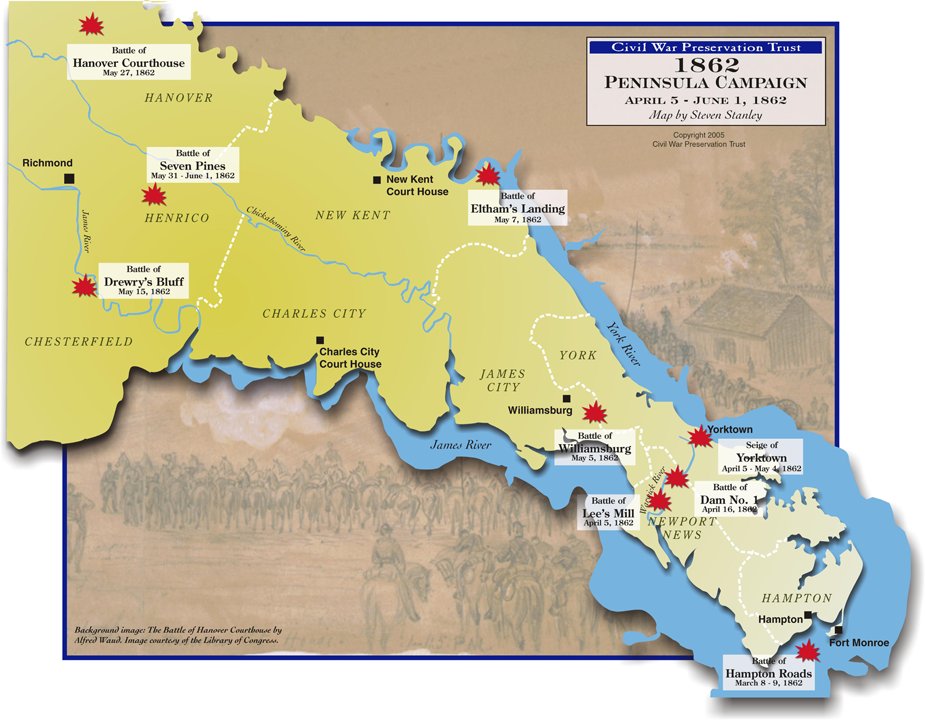
|
| Civil War Peninsula Campaign Battlefield Map |
| Civil War Peninsula Campaign & Seven Days Battles |
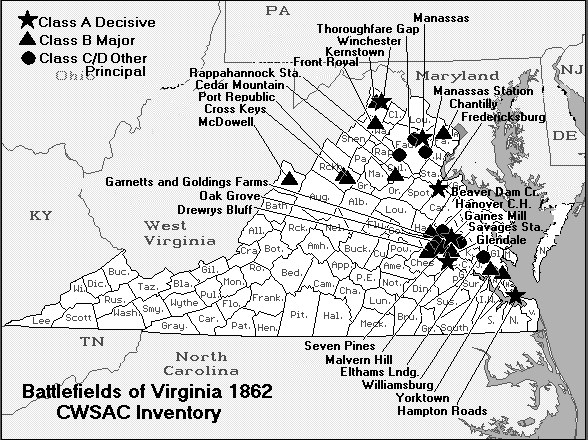
|
| Civil War Peninsula Campaign and Seven Days Battles Map |
The Peninsula Campaign [March–July 1862] consisted of the following battles during the Civil
War: Hampton Roads (aka Monitor vs. Virginia, or Battle of the Ironclads), Yorktown, Williamsburg (aka Fort Magruder),
Eltham's Landing (aka Barhamsville, West Point), Drewry's Bluff (aka Fort Darling, Fort Drewry), Hanover Court House (aka Slash Church), and Seven Pines (aka Fair Oaks, Fair Oaks Station). The following battles were part of the Seven
Days Battles, or Seven Days Battles Around Richmond, and completed or concluded the Peninsula Campaign: Oak Grove (aka French’s
Field, King’s School House), Beaver Dam Creek (aka Mechanicsville, Ellerson’s Mill), Gaines' Mill (aka First Cold Harbor), Garnetts & Goldings Farm, Savage's Station,
Glendale (aka Nelson’s Farm, Frayser’s Farm, Charles City Crossroads, White
Oak Swamp, New Market Road, Riddell's Shop), and Malvern Hill (aka Poindexter’s Farm).
The second phase of the Peninsula Campaign took a negative turn for the Union when Lee launched fierce counterattacks just
east of Richmond during the Seven Days Battles (June 25–July 1, 1862). Although they are formally
considered part of the Peninsula Campaign, the final battles of June 25 to July 1, with Lee in command and on the offensive
against McClellan, are popularly known as the Seven Days Battles.
| Civil War Forts, Fortresses, and Fortifications |
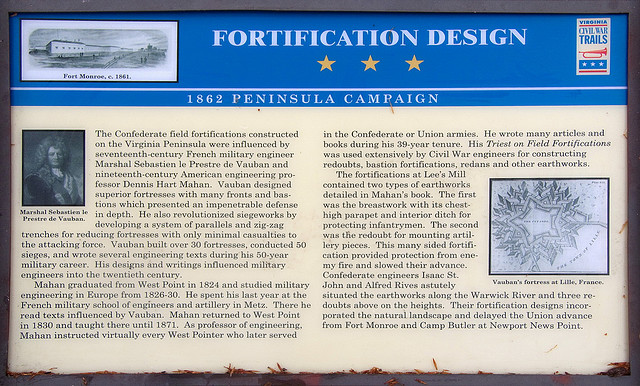
|
| (1862 American Civil War Peninsula Campaign) |
Following
the Federal fiasco at First Manassas, Major General George B. McClellan replaced McDowell as commander of the Federal forces.
He whipped the Federal Army of the Potomac into fine fighting trim, but was slow to move the army southward. After repeated
urging by the Lincoln government, McClellan finally decided to move against Richmond via the Yorktown Peninsula in March,
1862. However, it would be May before the troops actually saw any action.
From the Southern perspective, the defense of the Yorktown Peninsula was a major problem. Indeed, the overall Virginia theater
had a dismal outlook, with some 70,000 Confederates facing at least 200,000 Union troops.
The defense of the peninsula was handed to Major General John Bankhead Magruder, who, despite inadequate resources,
set to work with enthusiasm. He had a long defensive line constructed with Yorktown serving as its left flank. A secondary
line was built some ten miles back from the first, just in front of Williamsburg. General Robert E. Lee, serving in an advisory
capacity to President Davis at that time, was afraid these lines might be outflanked, and on his advice, a third line was
constructed about 10 miles in front of Richmond, with flanks anchored on the Chickahominy and James Rivers.
Magruder used his meager resources to their maximum effect, and by bluffing with the forces he had at hand, gave McClellan
cause for hesitation in attacking. However, McClellan was having problems with his own government as well. On April 4, he
learned that Fort Monroe, with a 12,000 man Federal garrison, had been taken from his command authority. Also, McDowell's
38,000 man corps would not be joining him on the Peninsula, but would be kept near Washington for its defense. Finally, he
also learned that a stop had been put to additional Federal recruiting efforts.
Based on these distressing new developments,
McClellan decided a siege was the solution. By early May he had set up 15 ten-gun batteries of 13" siege mortars. General
Joe Johnston, now in command of Confederate field forces, did not want to face a bombardment by this heavy artillery, and
ordered evacuation of Yorktown on May 3, leaving behind some 56 heavy siege guns of his own with ammunition, which McClellan
added to his already plentiful supply. On May 5, the Confederate rear guard engaged the Federal advance elements in the battle
of Williamsburg, and Johnston successfully pulled back even closer to Richmond.
Lee learned on May 16 that McDowell and some 40,000 Federal troops would be moving south toward the Confederate capital. This
was a disaster in the making for the Confederacy. With McClellan poised to the east, opposed only by Johnston's forces; Johnston
could not move to intercept McDowell without risking the capture of Richmond by McClellan. On the other hand, if Johnston
did not move, then McDowell would take the city. The solution to this problem lay in the character of President Abraham Lincoln.
He was always incredibly concerned about any threat to his capital, and whenever he perceived such a threat Lincoln invariably
overreacted. Thus Major General Thomas J. "Stonewall" Jackson was ordered to make an aggressive show in the Shenandoah Valley
that would cause a perceived threat to Washington, D.C.
| Civil War Peninsula Campaign Route Map |
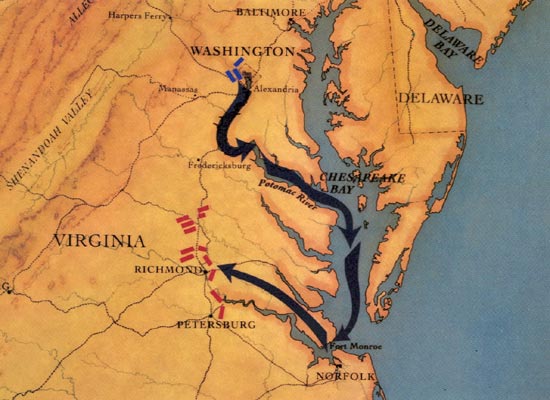
|
| (Courtesy pbs.org) |
| Union Gen. McClellan and Confederate Gen. Johnston |
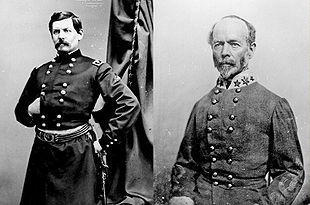
|
| Commanding General for Peninsula Campaign |
This sort of independent command made Jackson
very happy. After engaging a Federal force at Front Royal on May 23, he then pushed General Nathanial Banks from his supply
depot at Winchester on May 25. Besides netting some 3,000 prisoners, 9,000 small arms and tons of supplies, the operation
had the desired effect of causing Lincoln to order McDowell to halt his advance on Richmond and to try and intercept Jackson.
Actually, Lincoln may have reacted a little too well; since he saw a chance to trap Jackson and so ordered Fremont's command
from the west to take Harrisonburg and close the south end of the Shenandoah Valley.
Jackson however, did not "rattle" easily. He realized that his present location put him in a dangerous position. He was determined
to make good his escape and take all the captured Federal booty with him. Although it was a close race, Jackson broke through
the closing jaws of the Federal trap that resulted in a fight at Cross Keys on June 8 and a larger battle at Port Republic
on June 9. With only 17,000 men, Jackson had neutralized the threat to Richmond of some 60,000 Federal troops.
Johnston could see that Jackson was performing splendidly. Now all he had to do was defeat the 100,000 or so Federal troops
camped outside Richmond. Against this force, Johnston could bring some 70,000 Southern troops. The rain-swollen Chickahominy
River offered a possible opportunity. McClellan, against his better judgment, had been ordered to split his own army across
this river. Johnston saw that a rapid attack on the Federal wing on the south side of the river would give the Confederates
a local numerical superiority and a good chance for success since Federal reinforcements could be brought in very slowly,
at best.
The plan Johnston formulated was a good one, and
relatively simple to execute. The divisions of Longstreet, Hill and Huger would advance east along parallel roads to attack
Keyes in front of Seven Pines. However, the rain and mud caused everything that could go wrong to do just that. The march
was disorganized and delayed. Men were drowned in crossing White Oak Swamp. At the end of the day, the Confederates could
only claim the capture of 10 artillery pieces and 6,000 rifles. They had inflicted 5,000 casualties on the Federals, but had
suffered 6,000 themselves. It could hardly be called an overwhelming victory. Moreover, Johnston was badly wounded and had
to be relieved of command. The man that took his place was none other than Robert E. Lee. Lee had an uncanny ability
to "get into his opponent's head", and in the case of McClellan he saw that he would use his engineering expertise and superior
fire-power to move slowly forward from one entrenched position to the next until he finally took Richmond. However, before
Lee could cope with this, he needed time to improve his own defenses. Fortunately for the Confederacy, the next ten days were
continuous rain and McClellan's heavy artillery train was immobilized. The Confederates neutralized any attempt to bring them
up by rail by their own 32-pounder artillery piece mounted on a railroad car -- the first railroad gun in history. Shovels
soon replaced muskets in the troops' hands and the earth was seen flying in the construction of new fortifications.
Lee pulled reinforcements from every quarter until he could muster an effective force of about 85,000 men. The new plan was
to leave some 30,000 south of the Chickahominy in the newly-constructed entrenchments to hold McClellan's 75,000 on that side
of the river and use the remaining 55,000 Southern troops to crush the 30,000 Federals on the north bank. If Lee were successful
in defeating and destroying a large portion of this force, he would then capture McClellan's supply base and force him out
into the open. During June 12-15, J.E.B. Stuart's Southern cavalry rode completely around the Federal army, spreading confusion
and confirming the Federal dispositions. Jackson was returning from his Shenandoah Valley campaign and was due to arrive on
June 25. To allow for possible delays, Lee planned the Confederate attack for June 26.
| Virginia Civil War Battlefields of 1862 |
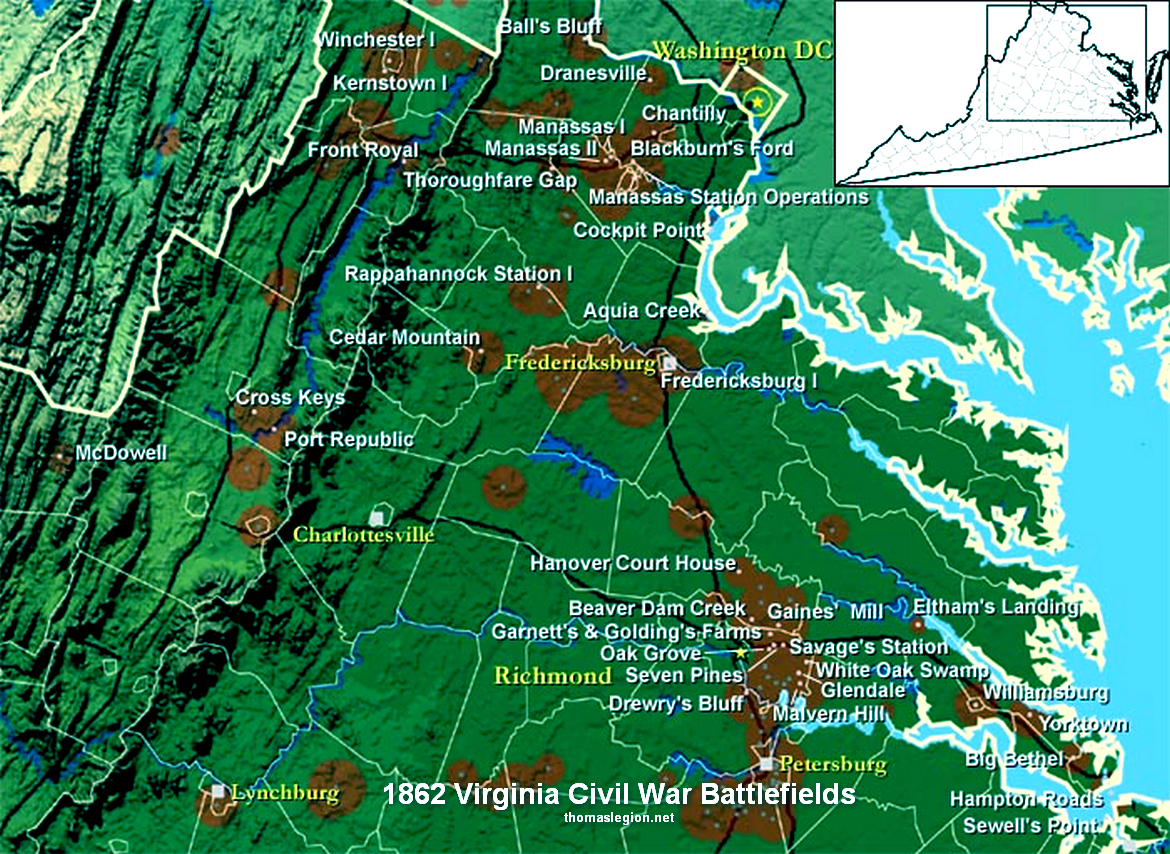
|
| Seven Days Battles and the Peninsula Campaign |
| Civil War Seven Days Battles Map |
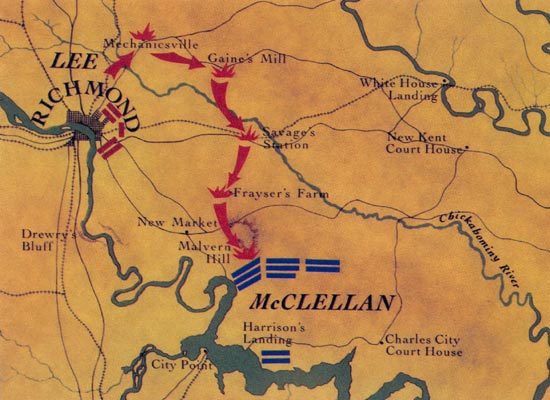
|
| (Courtesy pbs.org) |
McClellan, for his part, was now convinced
that he faced a massive army of some 200,000 Confederate troops and was badly outnumbered. If he really believed this was
the situation, his subsequent actions during the confusing series of battles known as the Seven Days, become somewhat more
understandable. To McClellan it seemed only logical that if Lee was attacking with 55,000 on the north bank of the Chickahominy,
it must be a diversionary attack and the real blow would come in the south. The only prudent thing therefore, would be to
fall back on the James River and Harrison's Landing.
The Confederates,
after some minor fighting on June 25, moved north out of Richmond on June 26. Mechanicsville was taken easily, but an attempt
to move east across Beaver Dam Creek was stopped by Federal forces in strong defensive positions. Jackson was supposed to
have arrived and turned the flank of the position, but he did not show up that day.
The morning of June 27, the Beaver Dam Creek position was carried but only because the Federals had fallen back to another
prepared position on Turkey Hill behind the Boatswain's Swamp Creek. Fitz-John Porter's command of 35,000 Federal troops was
protected by a triple line of entrenchments with artillery support and marshy ground to their front. When Jackson's troops
finally arrived that evening, the position was carried but with heavy Confederate casualties.
On Saturday, June 28, Lee spent much of the day trying to ascertain exactly where McClellan was retreating to. When Lee realized
that McClellan was obviously falling back on the James River, he had to revise his earlier plans and decided to try and catch
the Federals on either side of White Oak Swamp. The following day, Magruder was ordered to link up with Jackson and attack
the retreating Federals. The Confederates were badly handled in a clash at Savage Station, primarily because Jackson again
failed to show up on time. However, McClellan was forced to abandon much of his supplies, and an ammunition train sent forward
to the Chickahominy railway bridge exploded with impressive results.
Monday, the sixth of the Seven Days, saw a remarkable lack of cooperation among the elements of the Confederate pursuit. Huger
decided to cut an alternate road through the thick forest when he found his designated road blocked by felled trees. Holmes
command ran into a naval bombardment. Jackson, who had difficulty in crossing the White Oak Swamp Creek, decided to lie down
and take a nap at about 3:00 p.m.! As a result, only Longstreet's and A.P. Hill's troops were really involved in any fighting
that resulted in another loss of some 3,300 Confederates at Glendale.
| Seven Days Battles Map |
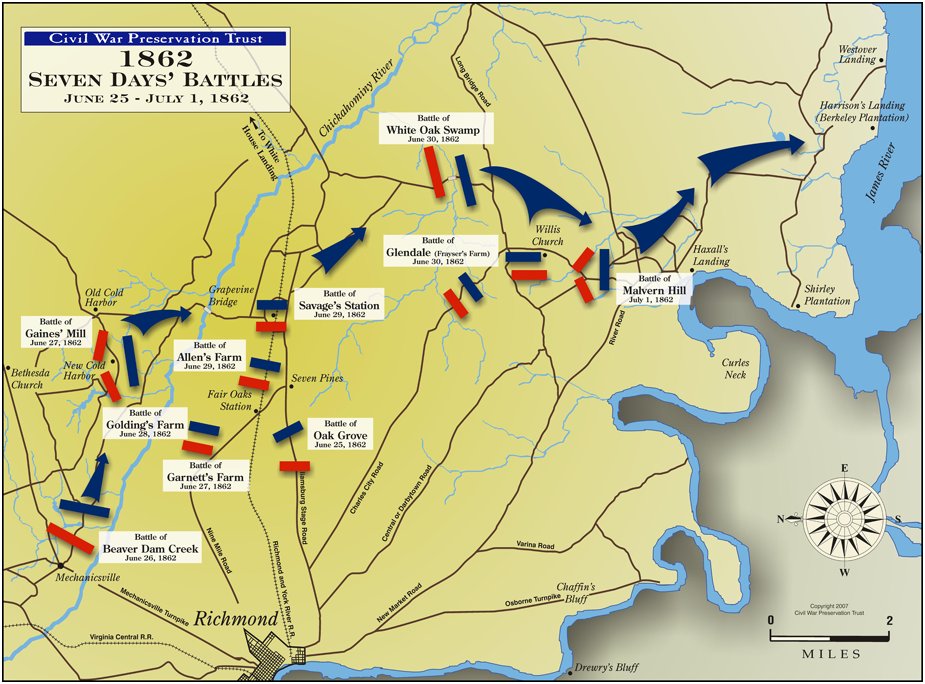
|
| Seven Days Battles and the Peninsula Campaign Battlefields |
| Union Gen. McClellan and Confederate Gen. Lee |
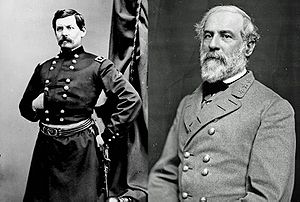
|
| Commanding Generals for Seven Days Battles |
On July 1,
the last of the Seven Days, Lee discovered that McClellan was protecting the last leg of his retreat by taking position on
Malvern Hill. This defensive position was held by Porter and Keyes with two divisions each, more than one hundred artillery
pieces, and a further four divisions in reserve. It looked formidable and it was. Lee first attempted to bring his artillery
to bear on the position, but it soon became apparent that he was out-gunned. Lee looked for, and failed to find, a satisfactory
alternative approach, but confusion in orders resulted in Huger, Magruder, and Hill launching a series of uncoordinated Confederate
assaults. These resulted in nothing but another 5,500 Southern casualties. Jackson again failed to arrive in time to assist
in the battle.
The series
of hammer blows Lee had delivered during the Seven Days had achieved its objective of relieving Richmond from McClellan's
forces. However, this had been accomplished at a very high cost. The Confederates lost 20,614 casualties compared to Federal
losses of 15,849.
The Seven Days
Battles, which concluded the Peninsula Campaign, was the bloody sequence of battles around Richmond, Virginia, that began
on June 25, 1862, and lasted for a week. Determined to hurl the Union forces back from the Confederate capital, Richmond,
Lee attacked McClellan again and again - at Mechanicsville, Gaines' Mill, Savage's Station, Frayser's Farm, and Malvern Hill.
McClellan won four out of the five battles, but proved as fearful in victory as he was in defeat, backing and retreating steadily
away until he reached Harrison's Landing on the James. The Peninsula Campaign, begun with such bright hope, had ended in defeat.
Peninsula Campaign with Summary Timeline of
Principal Events
| March17, 1862 |
Embarkation of the Army of the
Potomac commenced at Alexandria, Va. |
| March 26, 1862 |
Confederate Department of Henrico,
under command of Brig. Gen. John H. Winder, extended to embrace Petersburg and vicinity. |
| March 27, 1862 |
General Joseph E. Johnston, C.
S. Army, ordered to re-enforce the Army of the Peninsula. |
| March 31, 1862 |
Blenker's division ordered to
Mountain (Frémont's) Department. |
| April 1-2, 1862 |
Headquarters Army of the Potomac
transferred to vicinity of Fort Monroe. |
| April 4, 1862 |
The First Army Corps (McDowell's)
detached from Army of the Potomac and merged into Department of the Rappahannock. The Fifth Army Corps (Banks') merged into
the Department of the Shenandoah. |
| |
Skirmish at Howard's Mill, near
Cockletown. |
| April 5, 1862 - May 4, 1862 |
Siege of Yorktown. |
| April 11, 1862 |
Confederate naval operations in
Hampton Roads. |
| April 12, 1862 |
Command of General Joseph E. Johnston,
C. S. Army, extended over the Departments of Norfolk and the Peninsula. |
| April 22, 1862 |
Franklin's division arrives at
Yorktown. |
| May 4, 1862 |
Skirmishes near Williamsburg.
|
| May 5, 1862 |
Battle of Williamsburg. |
| May 6, 1862 |
Williamsburg occupied by the Union
forces. |
| May 7, 1862 |
Engagement at West Point, Barhamsville,
or Eltham's Landing. |
| May 7 -8, 1862 |
Reconnaissance to Mulberry Point,
James River. |
| May 8, 1862 |
Naval demonstration upon Sewell's
Point. |
| May 9, 1862 |
Norfolk evacuated by the Confederate
forces. |
| |
Skirmish at Slatersville. |
| May 10, 1862 |
Norfolk and Portsmouth occupied
by the Union forces. |
| May 13, 1862 |
Skirmish at Baltimore Cross-Roads,
near New Kent Court-House. |
| May 15, 1862 |
Engagement at Fort Darling, James
River. |
| May 17, 1862 |
Maj. Gen. Irvin McDowell ordered
to move upon Richmond in co-operation with Major-General McClellan. |
| |
Expedition up the Pamunkey River.
|
| May 18, 1862 |
Brig. Gen. Fitz John Porter, U.S.
Army, assumes command of Fifth Army Corps (reorganized). |
| |
Maj. Gen. William B. Franklin,
U.S. Army, assumes command of Sixth Army Corps. |
| May 18 - 19, 1862 |
Reconnaissance toward Old Church. |
| May 19, 1862 |
Skirmish at City Point, James
River. |
| |
Skirmish at Gaines' Mill. |
| May 20 -23, 1862 |
Operations about Bottom's Bridge,
Chickahominy River. |
| May 21, 1862 |
Advance across Bottom's Bridge.
|
| May 22, 1862 |
Reconnaissance to New Castle and
Hanovertown Ferries. |
| May 23, 1862 |
Reconnaissance from Bottom's Bridge
toward Richmond. |
| |
Reconnaissance from Bottom's Bridge
to the Turkey Island Creek Bridge. |
| |
Skirmish at Ellison's Mill, near
Mechanicsville. |
| |
Skirmish at Hogan's, near New
Bridge. |
| May 24, 1862 |
McDowell's orders to move upon
Richmond suspended. Skirmish at New Bridge. Skirmish at Seven Pines. Skirmish at Mechanicsville. |
| |
Reconnaissance toward Hanover
Court-House. |
| May 25 -26, 1862 |
Expedition from Bottom's Bridge
to James River. |
| May 26, 1862 |
Reconnaissance toward Hanover
Court-House. 27, 1862. |
| |
Skirmish at Slash Church. |
| |
Skirmish at White Oaks. |
| May 27 -29,1862 |
Engagement at Hanover Court-House
(27th) and operations (28th-29th) in that vicinity. |
| May 28, 1862 |
Virginia Central Railroad Bridge,
on South Anna River, destroyed by Union forces. |
| |
Destruction of Confederate supplies
at Ashland. |
| May 29, 1862 |
Skirmish near Seven Pines. |
| |
Richmond and Fredericksburg Railroad
Bridge, on South Anna River, destroyed. |
| May 30, 1862 |
Skirmish near Fair Oaks. |
| |
Skirmish near Zuni. |
| May 31 - June 1, 1862 |
Battle of Fair Oaks, or Seven
Pines. |
| June 1, 1862 |
General Robert E. Lee, C. S. Army,
assumes command of the Army of Northern Virginia. |
| |
The Department of Virginia extended
and embraced in Maj. Gen. George B. McClellan's command, Maj. Gen. John E. Wool, U.S. Army, being assigned to the Middle Department,
and Maj. Gen. John A. Dix, U.S. Army, to command at Fort Monroe. |
| June 1 - 2, 1862 |
Reconnaissance beyond Seven Pines.
|
| June 2, 1862 |
Expedition to Wormley's Ferry,
Pamunkey River. |
| June 3 -7, 1862 |
Reconnaissance to the James River
to communicate with the Union fleet. |
| June 5, 1862 |
Skirmish at New Bridge. |
| June 7, 1862 |
Reconnaissance on east bank of
the Chickahominy. |
| June 8, 1862 |
Skirmish near Fair Oaks. |
| |
Major-General McDowell ordered,
under conditions stated, to operate in the direction of Richmond. |
| |
Reconnaissance on the New Market
Road. |
| June 11, 1862 |
Re-enforcements sent from Army
of Northern Virginia to the Valley District. |
| June 12 - 13, 1862 |
McCall's division re-enforces
the Army of the Potomac. |
| June 13 - 15, 1862 |
Stuart's raid, including skirmishes
at Hawes' Shop, Old Church, and Garlick's Landing. |
| June 15, 1862 |
Reconnaissance to vicinity of
New Market. |
| |
Skirmish near Seven Pines. |
| |
Parley between Brig. Gen. Howell
Cobb, C. S. Army, and Col. Thomas M. Key, U.S. Army. |
| June 17, 1862 |
Jackson's command moves from vicinity
of Staunton and Weyer's Cave for the Peninsula. |
| June 18, 1862 |
Skirmish near Fair Oaks. |
| |
Skirmish on Nine Mile Road, near
Richmond. |
| June 19, 1862 |
Skirmish on the Charles City Road,
near Richmond. |
| June 20, 1862 |
Skirmish near New Bridge. |
| |
Affair at Gill's Bluff, James
River. |
| June 21, 1862 |
The Confederate Department of
North Carolina extended to the south bank of James River. |
| |
Skirmish near Fair Oaks Station.
|
| June 22 - 23, 1862 |
Reconnaissance to the left of
White Oak Swamp. |
| June 23, 1862 |
Operations about New Kent Court-House. |
| June 24, 1862 |
Skirmish near Mechanicsville.
|
| June 25 - July 1, 1862 |
"The Seven Days Battles." |
| June 27, 1862 |
Jackson re-enforces Army of Northern
Virginia. |
| June 28, 1862 |
Expedition from Fort Monroe to
open communication with Army of the Potomac. |
| July 2, 1862 |
Skirmish near New Kent Court-House.
Skirmish at Malvern Hill. Affair near Haxall's Landing. |
| July 3, 1862 |
Reconnaissance from Harrison's
Landing, on Charles City Road. |
| July 3 - 4, 1862 |
Skirmishes near Herring Creek,
or Harrison's Landing. |
| July 4, 1862 |
Reconnaissance from Harrison's
Landing. |
| |
Skirmish at Westover. |
| July 5 - 6, 1862 |
Operations against Union shipping,
James River. |
| July 7 - 9, 1862 |
Reconnaissance from Yorktown.
|
| July 9, 1862 |
Reconnaissance on the Long Bridge
Road. |
| July 10, 1862 |
Reconnaissance from Harrison's
Landing toward White Oak Swamp and skirmish. |
| July 11, 1862 |
Reconnaissance from Harrison's
Landing beyond Charles City Court-House, Va. |
| July 16, 1862 |
Reconnaissance from Westover,
on the Richmond Road. |
| July 22, 1862 |
Maj. Gen. John A. Dix assumes
command of the Seventh Army Corps, Department of Virginia. |
| |
Maj. Gen. A. E. Burnside assumes
command of the Ninth Army Corps. |
| |
Affair near Westover. |
| July 22 - 30, 1862 |
Scout in King William, King and
Queen, and Gloucester Counties. |
| July 23, 1862 |
Maj. Gen. Henry W. Halleck assumes
command of the Armies of the United States. |
| July 29, 1862 |
Reconnaissance from Harrison's
Landing to Saint Mary's Church. |
| July 30, 1862 |
McClellan ordered to remove his
sick, etc. |
| |
Reconnaissance from Harrison's
Landing to Jones' Ford, Chickahominy River. |
| July 31 - August 1, 1862 |
Attack on Union camps and shipping
between Shirley and Harrison's Landing. |
| August 2 - 8, 1862 |
Reconnaissance from Harrison's
Landing and reoccupation of Malvern Hill by the Union forces. |
| August 3, 1862 |
Reconnaissance on south side of
James River and skirmish at Sycamore Church. |
| |
McClellan ordered to withdraw
his forces to Aquia Creek. |
| August 4 - 5, 1862 |
Reconnaissance from Coggins Point
beyond Sycamore Church. |
| August 5, 1862 |
Skirmish at White Oak Swamp Bridge.
|
| |
Engagement at Malvern Hill. |
| August 6, 1862 |
Skirmish at Malvern Hill. |
| August 13, 1862 |
Preliminary orders issued for
the movement of the Army of Northern Virginia from the Peninsula. |
| August 14 - 15, 1862 |
The Third and Fifth Army Corps
move from Harrison's Landing for Aquia Creek |
| August 14 - 19, 1862 |
Operations of the cavalry covering
the rear of the Army of the Potomac from Harrison's Landing to Williamsburg. |
| August 17, 1862 |
Reconnaissance toward Forge Bridge.
|
| August 20, 1862 |
The Fifth Army Corps embarked
at Newport News. |
| August 21, 1862 |
The Third Army Corps sail from
Yorktown. |
| August 23, 1862 |
The Sixth Army Corps embarked
at Fort Monroe. |
| August 26, 1862 |
The Second Army Corps left Fort
Monroe. |
(Sources and related reading below.)
Recommended
Reading: The Richmond Campaign of 1862: The Peninsula and the Seven Days (Military Campaigns of the Civil War), by Gary W. Gallagher. Description: The Richmond campaign of April-July
1862 ranks as one of the most important military operations of the first years of the American Civil War. Key political, diplomatic,
social, and military issues were at stake as Robert E. Lee and George B. McClellan faced off on the peninsula between the
York and James Rivers. The climactic clash came on June 26-July 1 in what became known as the Seven Days battles, when Lee,
newly appointed as commander of the Confederate forces, aggressively attacked the Union army. Casualties for the entire campaign
exceeded 50,000, more than 35,000 of whom fell during the Seven Days. Continued below…
This book offers
nine essays in which well-known Civil War historians explore questions regarding high command, strategy and tactics, the effects
of the fighting upon politics and society both North and South, and the ways in which emancipation figured in the campaign.
The authors have consulted previously untapped manuscript sources and reinterpreted more familiar evidence, sometimes focusing
closely on the fighting around Richmond
and sometimes looking more broadly at the background and consequences of the campaign. About the Author: Gary W. Gallagher
is John L. Nau III Professor of History at the University of Virginia.
He has published widely on the Civil War, including six previous titles in the Military Campaigns of the Civil War series,
and he is also a contributing Civil War historian for the History Channel.
Recommended
Reading: To The Gates of Richmond: The Peninsula Campaign, by Stephen Sears. Description: To the Gates of Richmond charts the Peninsula Campaign of 1862, General George McClellan"s
grand scheme to march up the Virginia
Peninsula and take
the Confederate capital. For three months McClellan battled his way toward Richmond, but then Robert E. Lee took command
of the Confederate forces. In seven days, Lee drove the cautious McClellan out, thereby changing the course of the war. Intelligent
and well researched, To the Gates of Richmond vividly recounts one of the bloodiest battles of the Civil War. Continued below...
Publishers
Weekly: Sears complements his 1988 biography of George McClellan with this definitive analysis of the general's principal
campaign. McClellan's grand plan was to land an army at Yorktown, move up the Virginia peninsula toward
Richmond,
and fight a decisive battle somewhere near the Confederate capital, thereby ending the Civil War while it was still a rebellion
instead of a revolution. The strategy failed in part because of McClellan's persistent exaggerations of Confederate strength,
but also because under his command the Federals fought piecemeal. The Confederates were only marginally more successful at
concentrating their forces, but Sears credits their leaders, especially Lee, as better able to learn from experience. Confederate
victory on the Peninsula meant the Civil War would continue.
The campaign's heavy casualties indicated the kind of war it would be.
Recommended
Reading: Seven Days Before Richmond:
McClellan's Peninsula Campaign Of 1862 And Its Aftermath (2009) (Hardcover) (728 pages). Description: This exhaustive volume, Seven Days Before
Richmond, combines meticulous research with a unique perspective and examines the 1862 Peninsula Campaign of Union General
George McClellan and the profound effects it had on the lives of McClellan and Confederate General Robert E. Lee, as well
as its lasting impact on the war itself. Continued below…
Rudolph Schroeder’s
twenty-five year military career and combat experience bring added depth to his analysis of the Peninsula Campaign, offering
new insight and revelation to the subject of Civil War battle history. Schroeder analyzes this crucial campaign from its genesis
to its lasting consequences on both sides. Featuring a detailed bibliography and a glossary of terms, this work contains the
most complete Order of Battle of the Peninsula Campaign ever compiled, and it also includes the identification of commanders
down to the regiment level. In addition, this groundbreaking volume includes several highly-detailed maps that trace the Peninsula
Campaign and recreate this pivotal moment in the Civil War. Impeccably detailed and masterfully told, Seven Days Before Richmond
is an essential addition to Civil War scholarship. Schroeder artfully enables us to glimpse the innermost thoughts and motivations
of the combatants and makes history truly come alive.
Recommended
Reading: The Peninsula Campaign of 1862: A Military Analysis (Hardcover). Description: The largest offensive of the Civil War,
involving army, navy, and marine forces, the Peninsula Campaign has inspired many history books. No previous work, however,
analyzes Union general George B. McClellan's massive assault toward Richmond in the context of current and enduring military doctrine.
The Peninsula Campaign of 1862: A Military Analysis is an effort to fill this void. Background history is provided for continuity,
but the heart of this book is in military analysis and the astonishing extent to which the personality traits of generals
will often overwhelm even the best efforts of their armies. Continued below…
The Peninsula
Campaign lends itself to such a study. In the book, lessons for those studying the art of war are many. On the waters, the
first ironclads forever changed naval warfare (Monitor v. Merrimack).
At the strategic level, McClellan's inability to grasp Lincoln's grand objective becomes evident. At the operational level,
Robert E. Lee's difficulty in synchronizing his attacks deepens the mystique of how he achieved so much with so little. At
the tactical level, the Confederate use of terrain to trade space for time allows for a classic study in tactics. Moreover,
the campaign is full of lessons about the personal dimension of war. McClellan's overcaution, Lee's audacity, and Jackson's
personal exhaustion all provide valuable insights for today’s commanders and for Civil War enthusiasts still debating
this tremendous struggle. Historic photos and detailed battle maps make this study an invaluable resource for those touring
all the many battlegrounds from Young's Mill and Yorktown through Fair Oaks
to the final throes of the Seven Days Battles.
Recommended Reading: Richmond Burning: The Last Days of the Confederate Capital.
Review: When conquering Union soldiers entered Richmond, Virginia,
in the first days of April, 1865, they found a city afire, reduced to desperation, but still defiant. Virginia historian Nelson Lankford reconstructs the final hours of the Confederacy's heart
in this vivid narrative, which draws on contemporary letters, diaries, and official reports that share both immediacy and
a sense of awe at the terrible destruction. Continued below…
Just why the capital burned has
long been a subject of speculation; by Lankford's account, much of the damage was due to the defenders' last-minute efforts
to destroy war materiel, setting fires that soon spread. Lankford attends to other legends as well, including a reported call
on Confederate general George Pickett's home by none other than Abraham Lincoln, while offering verifiable vignettes of such
moments as Robert E. Lee's return to the capital and the celebrations of newly liberated slaves and Union prisoners. Lankford's
narrative offers a view much different from what he calls "the warm sepia glow cast over our great national trauma by popular
books and documentary films." It is a fine effort, and one that students of the Civil War should welcome.
Recommended
Reading: Extraordinary Circumstances: The Seven Days Battles. Description: The Seven Days Battles were fought southeast of the
Confederate capital of Richmond
in the summer of 1862, and it was the first campaign in the Civil War in which Robert E. Lee led the Army of Northern Virginia.
Lee and his fellow officers, including "Stonewall" Jackson, James Longstreet, A. P. Hill, and D. H. Hill, pushed George B.
McClellan's Army of the Potomac from the gates of Richmond to
the James River, where the Union forces reached safety. Along
the way, Lee lost several opportunities to harm McClellan. The Seven Days have been the subject of numerous historical treatments,
but none more detailed and engaging than Brian K. Burton's retelling of the campaign that lifted Southern spirits, began Lee's
ascent to fame, and almost prompted European recognition of the Confederacy. Continued below…
Reviews:
"A full and
measured account marked by a clear narrative and an interesting strategy of alternating the testimony of generals with their
grand plans and the foot soldiers who had to move, shoot, and communicate in the smoky underbrush." -- The Virginia Magazine
"A thoroughly
researched and well-written volume that will surely be the starting point for those interested in this particular campaign."
-- Journal of American History
"A welcome
addition to scholarship that should be the standard work on its subject for some time to come." -- Journal of Military History
"A well-written,
thoroughly researched study of the Seven Days.... Provides thorough and reasonable analyses of the commanders on both sides."
-- Georgia
Historical Quarterly
Sources: Epic Battles Of the Civil War, 1861-1865 (InfoConcepts, Inc) by
Curtis M. Jingle, Michael R. Brasher, and Warren Von Worley; Official Records of the Union and Confederate Armies; Civil War
Preservation Trust (CWPT); pbs.org.
|

